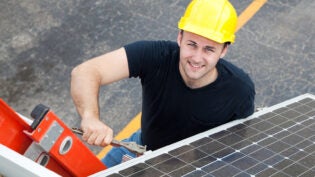5 Ways to Save Money By Making Your Office Sustainable
By: Angela Ash

There are many small ways you can save money in the office that are also sustainable. Being environmentally conscious doesn’t just produce a feel-good vibe and signal to your customers that you care about the environment. It can also help reduce the amount of money it costs to run your company.
Here are five ways you may be able to save money while making your workplace more sustainable:
1. Leverage the Federal Solar Tax Credit
The Federal Solar Tax Credit is an incentive that lets businesses claim a 26% tax credit after installing solar-connected storage solutions or solar photovoltaic (PV) panels. The credit, designed to make investing in green technologies more affordable, is available through the Internal Revenue Service (IRS).
In some areas, companies could be eligible for state credits as well. For example, South Carolina has a 25% state tax credit for solar installation.
This tax credit is set to drop to 22% in 2023 and phase out completely for homeowners in 2024. For business owners, the credit will decrease to 10% in 2024 and beyond, so it’s important to take advantage of the program now if adding solar to your operation is on your to-do list.
2. Install Motion-Activated Light Switches Throughout the Office
Motion-activated light switches are everywhere; both retail and traditional office settings depend on this technology to help reduce energy usage. Conference rooms, bathrooms and long hallways need adequate lighting, but only when there is someone present. Motion-activated switches sense the presence of a human and flip the lights on automatically. As a bonus, there’s no need to search around in a windowless room to find the light switch with motion-activated technology. Although the installation may cost a bit more, the long-term savings are noticeable enough that motion-activated lights are often included automatically with new construction projects.
3. Install Electric Vehicle (EV) Charging Stations or Purchase New Company EVs To Get a Tax Credit
When you decide to make it easy for your employees to charge their EVs by installing EV charging stations, you may be eligible for federal and state tax incentives to help offset the hardware and installation costs.
If you have a fleet of company vehicles, consider replacing them with EVs as needed to take advantage of further tax incentives of up to $7,500 per vehicle. Not every EV qualifies for the full amount, but highly rated EVs provide thousands of dollars in tax credits for individuals and businesses. For example, the Ford Focus Electric (2012 – 2018) has a 33.5kWh battery and comes with a $7,500 tax credit. The Subaru Crosstrek Hybrid (2019 and later) provides a tax credit of $4,502. The BMW i8 (2014-2017) earns owners a tax credit of $3,793.
4. Reduce Paper Use
“Go paperless” was a popular command for businesses 20 years ago, but we have yet to see truly paperless workplaces. Instead of giving up and returning to wasteful habits, concentrate on simply reducing the amount of paper used throughout the course of day-to-day business.
- Ask vendors to provide e-statements and invoices to reduce the amount of paper that ends up in your company’s shredders.
- Ask employees to participate in direct deposit and make sure they have easy access to their pay stubs and tax paperwork so they can access those documents online.
- If possible, review digital files on computers or tablets instead of automatically printing paperwork.
- When you must print a document, print only the pages you need (unless it requires a signature or is an official contract).
5. Enable Power-Saving Mode or Sleep Mode Across All Company-Owned Electronic Devices
Power-saving and sleep mode not only optimizes CPU battery life and speed, but it also reduces the amount of phantom energy usage throughout your company.
Talk with your IT department to make sure that they are making the most of these settings that allow unused or idle devices to shut down after a predetermined amount of time. Be sure to ask them if they have other ideas about how you can reduce the amount of energy required by your company’s electronic infrastructure. They may be able to help employees install smart power strips, which automatically shut off power to electronic devices when they go into standby mode.
Making changes in a company doesn’t always make you popular, and when you are trying to make your office more sustainable, some people may see your efforts as an inconvenience. It may help to be transparent about your motives. Let your customers and employees know the “why” behind your actions to give them a reason to help you make small changes for the greater good.
1960 Views












